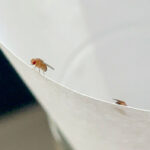Are tiny bugs buzzing around your fruit bowl or kitchen sink? You might be dealing with fruit flies! These common household pests can be a nuisance, but thankfully, getting rid of fruit flies is usually a quick and inexpensive task. You likely already have everything you need right in your kitchen cabinets.
Recently, we experienced a fruit fly invasion in our own home – a rare occurrence in the four years we’ve lived here. This unexpected situation became the perfect opportunity to put various fruit fly elimination methods to the test. After thorough experimentation and careful note-taking, we’re excited to share the most effective homemade fruit fly traps and guide you through creating them.
These DIY traps are incredibly easy to assemble using natural, everyday ingredients you probably already have. Plus, if you prefer a humane approach, many of these traps allow you to release the captured fruit flies outdoors. We’ll also cover essential tips for preventing future fruit fly infestations in your home.
Understanding Fruit Flies
Fruit flies are small, winged insects that are strongly attracted to ripe and fermenting fruits and vegetables – hence their name. They are also drawn to sugary substances like juice, beer, and wine, as well as decaying organic matter. You’ll often find them congregating around fruit bowls, garbage disposals, trash cans, and even drains. Visually, fruit flies are about the size of a grain of rice and resemble small houseflies, typically tan or brownish in color, and often have distinctive red eyes. They are most prevalent during late summer and fall, coinciding with fruit harvest seasons.
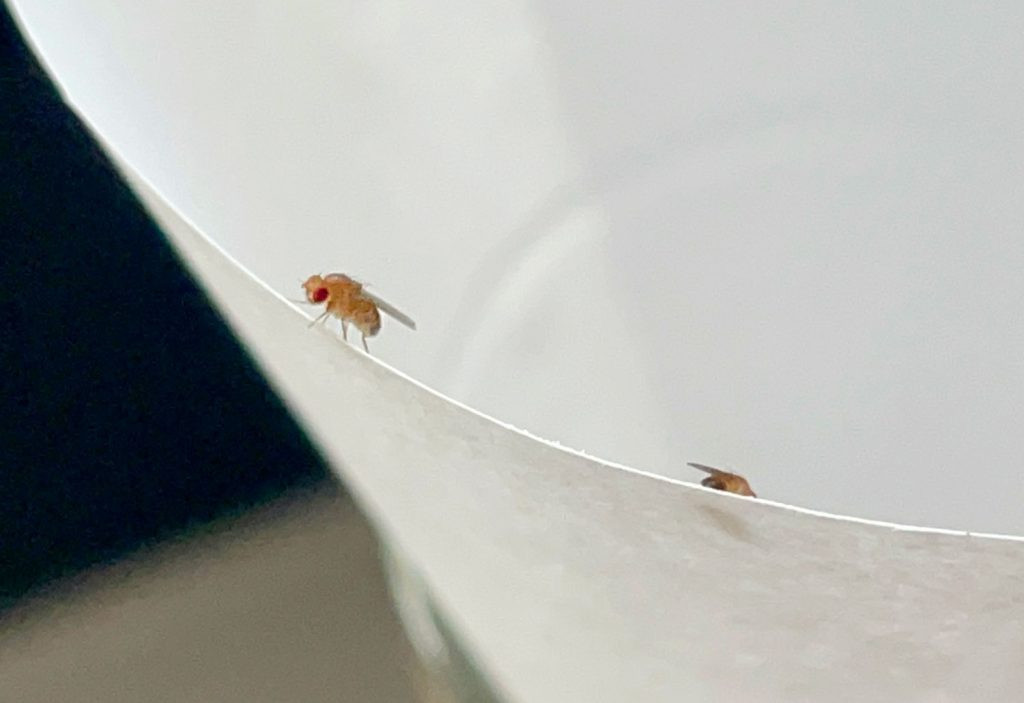 Close Up Of Fruit Fly On Paper Funnel
Close Up Of Fruit Fly On Paper Funnel
A fruit fly problem often starts with just a few of these pests entering your home, possibly hitching a ride on purchased produce. However, female fruit flies are prolific breeders, capable of laying hundreds of eggs in their short lifespan. These eggs can hatch in as little as 12 hours, and the flies can reach adulthood within days. This rapid life cycle means a small initial presence can quickly escalate into a full-blown infestation. Therefore, prompt action is key to effectively rid fruit flies and prevent them from multiplying.
Identifying Fruit Flies: Fruit Flies vs. Fungus Gnats vs. Drain Flies
Fruit flies are frequently mistaken for other small flying insects commonly found indoors, particularly fungus gnats and drain flies. Accurate identification is crucial because different pests may require different elimination strategies. The easiest way to distinguish them is by observing their location and resemblance to larger insects.
- Fruit Flies: Look like tiny flies. They are typically found near ripened fruit, open trash cans, spilled food, and other sources of fermenting food.
- Drain Flies: Resemble small, fuzzy moths. As the name suggests, they are usually seen near sink drains, bathtubs, and areas with moisture.
- Fungus Gnats: Look like small mosquitos with longer legs. They are commonly found around houseplants, as they breed in moist potting soil.
If you are uncertain about the type of pest you’re dealing with, trying one of the fruit fly traps detailed below can serve as a diagnostic tool. If the trap attracts the insects, you likely have fruit flies.
4 Simple DIY Fruit Fly Traps
Getting rid of fruit flies at home doesn’t need to be a complicated or expensive endeavor. With just a few common household items and a bit of patience, you can effectively manage and eliminate these pests. The principle behind each trap is the same: attract the fruit flies and then prevent their escape. We tested four popular DIY methods and found a clear winner. Since each method utilizes items you probably already have, experimenting with a few different traps is easy and worthwhile. Consider it a fun, mini science experiment in your kitchen! Here are the first four homemade fruit fly traps we tested:
- Funnel Trap
- Plastic Wrap Trap
- Dish Soap Trap
- Rotting Fruit Trap
Let’s explore each method in detail, along with our findings on their effectiveness. Keep in mind that some traps work faster than others, and it might take several days of consistent trapping to completely resolve a fruit fly problem.
#1: The Paper Funnel Fruit Fly Trap
This trap design uses a paper funnel to guide fruit flies into a container baited with an attractant. The narrow opening at the bottom of the funnel makes it easy for flies to enter but difficult for them to exit.
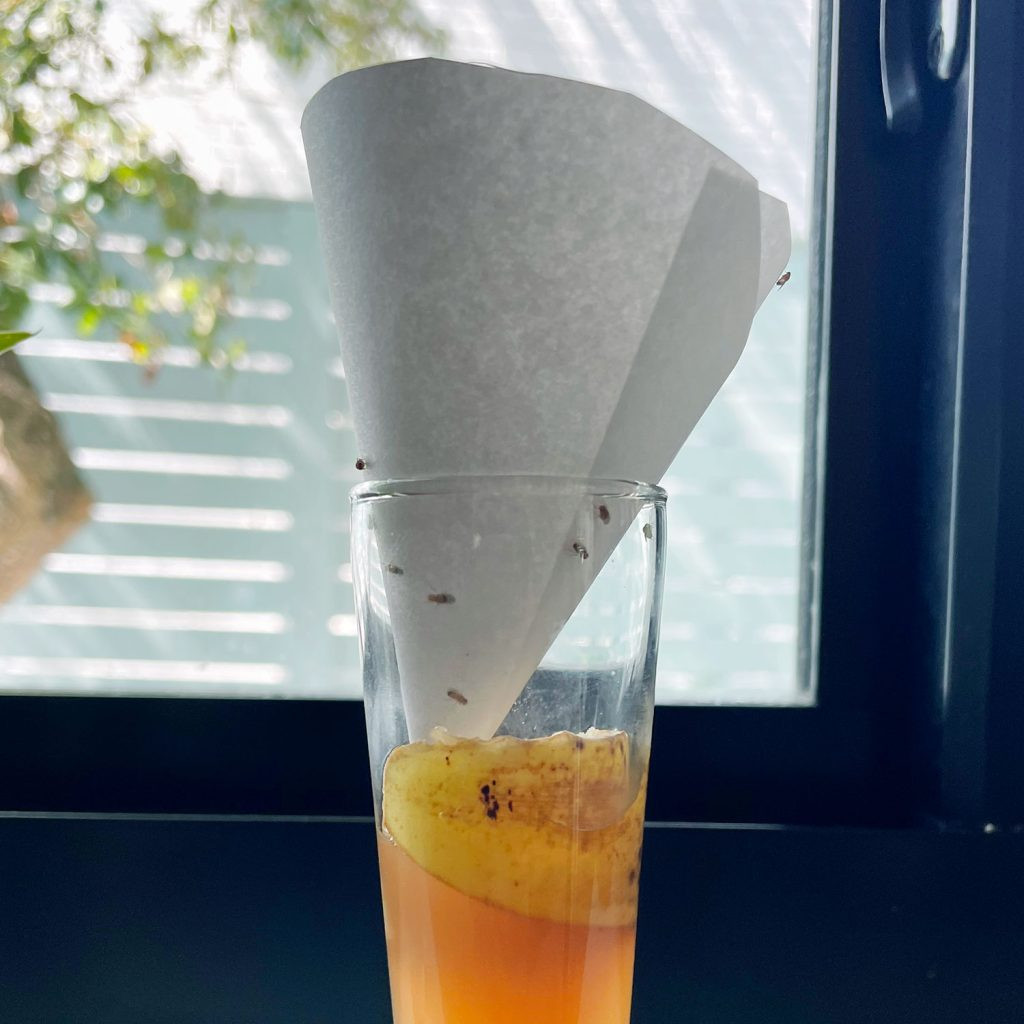 DIY Fruit Fly Trap With Paper Funnel
DIY Fruit Fly Trap With Paper Funnel
Materials You’ll Need:
- A small, clear jar, cup, or container – a narrow opening is preferable
- A sheet of paper or cardstock
- Tape
- Scissors
- Apple cider vinegar (ACV)
Step-by-Step Instructions:
- Select your container: Choose a small, clear container like a recycled food jar or a plastic bottle. A narrow opening helps to prevent escape.
- Add the attractant: Pour a small amount of apple cider vinegar, old beer, or wine into the bottom of the container. These liquids have strong, fruity, or fermented scents that are irresistible to fruit flies.
- Create the paper funnel: Roll a piece of paper or cardstock into a cone shape, ensuring a very small opening at the pointed end. Secure the cone shape with tape. You can trim the opening at the tip with scissors if needed; it only needs to be about the size of a grain of rice.
- Position the funnel: Place the paper funnel into the opening of your container. Adjust the funnel so that it sits securely on the rim of the container opening without touching the liquid at the bottom. Ensure there are no gaps around the edges where flies could escape.
- Humane release (optional): To release trapped flies, carefully carry the entire trap outdoors, keeping the funnel in place to prevent escapes. Once outside, remove the funnel to allow the fruit flies to fly away.
While you can use a store-bought funnel, the opening at the bottom is often too wide, which may allow captured fruit flies to escape. A homemade paper funnel with a very small opening is more effective for trapping.
#2: The Plastic Wrap Fruit Fly Trap
Similar to the funnel trap, this method uses apple cider vinegar to lure fruit flies into a container. The top of the container is sealed with plastic wrap pierced with tiny holes, allowing flies to enter but hindering their ability to get out.
Materials You’ll Need:
- A small, clear jar, cup, or container
- A rubber band
- Plastic wrap or a plastic bag
- A toothpick
- Apple cider vinegar (ACV)
Step-by-Step Instructions:
- Choose your container: Select a small, clear jar, cup, or any glass container. Clarity helps in monitoring the trap’s effectiveness, but even an opaque container like a can will work.
- Pour in the attractant: Add apple cider vinegar to the container. The strong scent is what draws the fruit flies in. Old beer or wine are also effective alternatives, but avoid using regular white vinegar, which is less appealing to fruit flies.
- Cover the opening with plastic wrap: Stretch plastic wrap tightly over the opening of the container and secure it firmly with a rubber band. You can use standard kitchen plastic wrap or cut a piece from a plastic bag.
- Poke small entry holes: Use a toothpick to carefully poke a few small holes in the plastic wrap covering. These holes should be large enough for a fruit fly to enter, but small enough to discourage them from easily finding their way back out.
- Humane release (optional): To release the trapped fruit flies, take the entire trap outside without removing the plastic wrap. Once outdoors, remove the plastic wrap to let the flies escape.
Alternatively, you can create a similar trap using a jar lid. Puncture a small hole in a metal jar lid using a hammer and nail, and screw the lid onto a jar containing the attractant.
#3: The Dish Soap Fruit Fly Trap
This trap is simpler than the previous two, as it doesn’t require a cover. It relies on the principle of surface tension reduction. The addition of dish soap to the attractant breaks the surface tension of the liquid, causing fruit flies to sink and become trapped. Note: This method is not designed for humane release, as the soap is lethal to the flies.
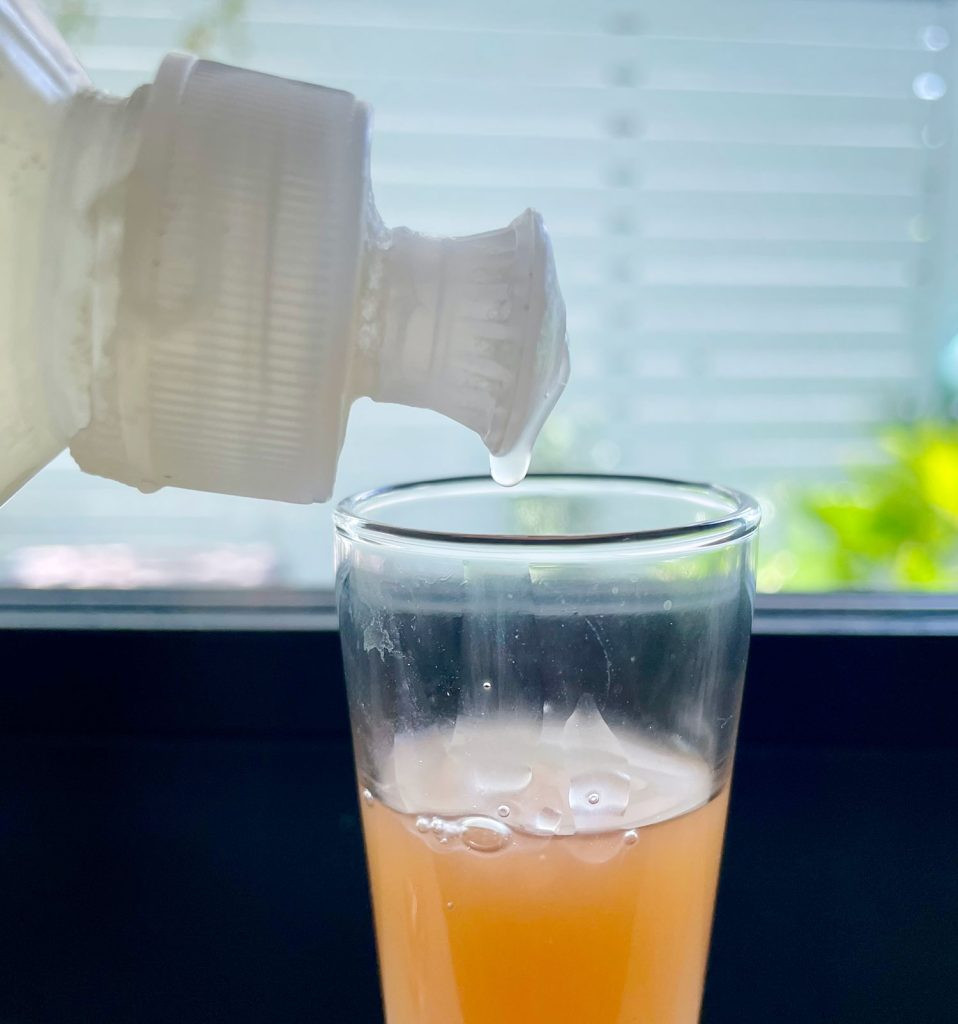 Dripping Dish Soap Into Apple Cider Vinegar For DIY Fruit Fly Trap
Dripping Dish Soap Into Apple Cider Vinegar For DIY Fruit Fly Trap
Materials You’ll Need:
- A small container, bowl, or dish
- Dish soap
- Apple cider vinegar (ACV)
Step-by-Step Instructions:
- Pour in apple cider vinegar: Fill the bottom of a small container, bowl, or dish with apple cider vinegar. The scent will attract the fruit flies.
- Add dish soap and mix: Add a few drops of dish soap to the apple cider vinegar. Gently mix to combine. The soap breaks the surface tension, trapping the flies when they land.
This dish soap method can also be enhanced by combining it with the plastic wrap or funnel traps. Simply add a few drops of dish soap to the apple cider vinegar before covering the container with plastic wrap or inserting the funnel. This provides an additional trapping mechanism.
#4: The Rotting Fruit Fruit Fly Trap
For a more natural lure, you can create a fruit fly trap using actual fruit as bait, which is often even more enticing to fruit flies than apple cider vinegar.
Materials You’ll Need:
- A small glass jar, cup, or container
- Plastic wrap or paper funnel, depending on your preferred trap style
- A small piece of ripe or overripe fruit, such as a banana peel or slice of apple
To make a rotting fruit trap, simply replace the apple cider vinegar in either the Plastic Wrap Trap or the Funnel Trap with a piece of banana peel, apple slice, or peach. You can also add a piece of fruit to your apple cider vinegar to enhance its attractiveness. However, be sure to replace the fruit every day or two to prevent unpleasant odors in your kitchen.
Determining the Best Fruit Fly Trap
To rigorously test the effectiveness of different trap combinations, we set up four distinct DIY traps in our kitchen. These included variations combining different trap designs and lures:
- Plastic Wrap Trap with banana peel
- Funnel Trap with ACV + banana peel
- Plastic Wrap Trap with ACV + dish soap
- Dish Soap Trap with ACV
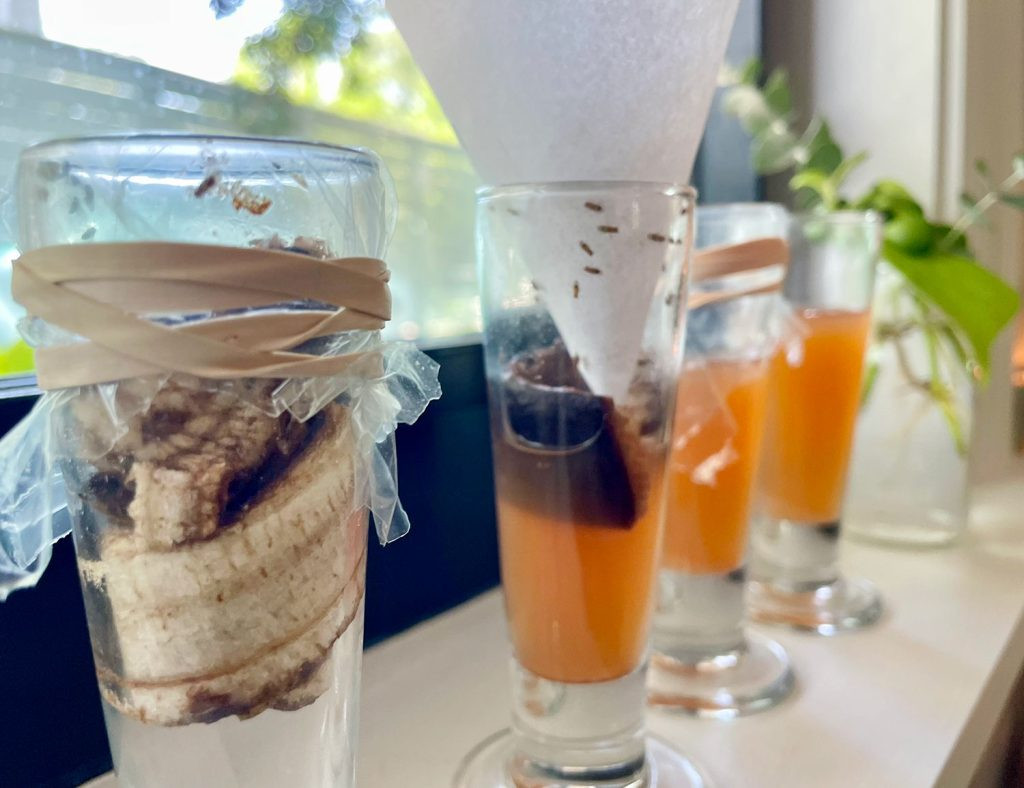 4 DIY Fruit Fly Traps Close Up
4 DIY Fruit Fly Traps Close Up
Our results indicated that the type of lure was more critical than the trap design. Traps using banana peel as bait were significantly more effective than those relying solely on apple cider vinegar. While both Plastic Wrap Traps were structurally similar, the one baited with banana peel dramatically outperformed the ACV and soap trap. This suggests that while apple cider vinegar is attractive, real fruit is even more irresistible to fruit flies.
Therefore, we recommend incorporating a piece of fruit into any DIY fruit fly trap you choose to set up. We found the plastic wrap trap slightly more convenient due to its ease of assembly and stability – we accidentally tipped over the funnel trap once, releasing some captured flies back into the kitchen!
What Lures Fruit Flies Most Effectively?
Driven by our success with fruit scraps, we decided to further investigate which type of fruit works best as bait. We tested three readily available fruits: banana peel, apple slices, and a strawberry. Each fruit was placed in a separate Plastic Wrap Trap, set side-by-side on the countertop for 24 hours.
While the banana peel initially seemed promising (it was the ripest at the start), the strawberry ultimately proved to be the most attractive lure for fruit flies. The banana peel still captured a good number of flies, but as the strawberry ripened further, it attracted even more. Interestingly, the apple slices didn’t catch a single fruit fly!
Considering Store-Bought Fruit Fly Traps
If DIY traps aren’t working for you, or if you prefer a ready-made solution, numerous effective store-bought fruit fly traps are available. These traps generally have excellent customer reviews and are typically priced under $20. They may be a good option if you want to catch a broader range of flying insects or prefer a more discreet trap design.
 Collage of Storebought Fruit Fly Traps
Collage of Storebought Fruit Fly Traps
During our experiment, we purchased a pack of Terro Fruit Fly Traps to compare their performance against our homemade traps. We placed a Terro trap next to our banana and strawberry traps for 24 hours to assess which performed best.
Again, our homemade strawberry trap was the most effective, closely followed by the banana peel trap. The store-bought trap caught only a single fruit fly in the initial 24-hour period. HOWEVER…
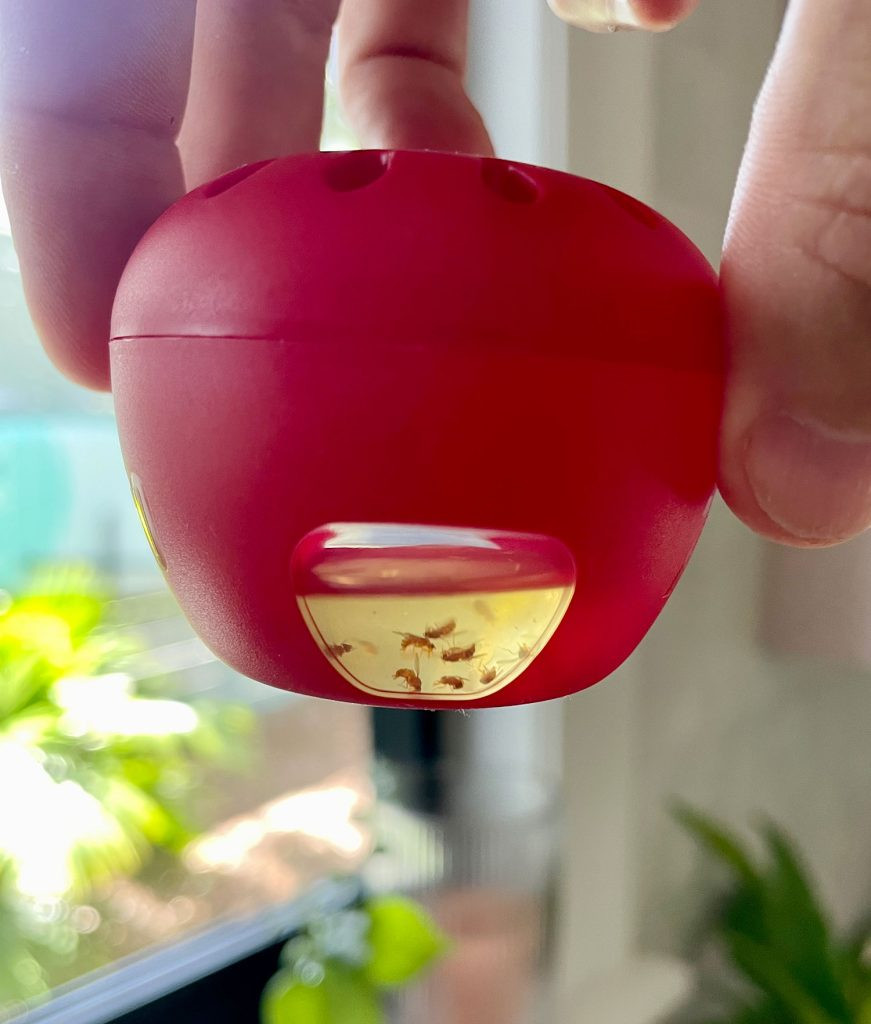 Terro Fruit Fly Trap With Dead Fruit Flies Visible
Terro Fruit Fly Trap With Dead Fruit Flies Visible
To ensure a fair comparison, we discarded our DIY traps and left the store-bought Terro trap out for another 24 hours. Over this extended period, the Terro trap accumulated a significant number of fruit flies, as shown in the image above. So, store-bought traps are definitely effective, but they might work more slowly than homemade traps. Our conclusion? Store-bought traps are a good choice if you prioritize discreetness, especially for long-term placement. However, for rapid fruit fly elimination, homemade traps are often the quickest and most effective solution.
Preventing Fruit Flies: Key Strategies
While eliminating fruit flies is relatively straightforward, preventing them from infesting your home in the first place is even better. Here are some simple yet effective preventative measures:
- Maintain clean kitchen surfaces: Regularly wipe down kitchen counters, stovetops, tables, and any surfaces that can collect food residues or spills. Fruit flies are particularly drawn to fruit, sugary liquids, and alcohol, so promptly clean up any spills.
- Regularly empty trash cans: Food scraps left in garbage cans, especially overnight, can quickly become breeding grounds for fruit flies. Empty your trash frequently, especially kitchen trash.
- Dispose of overripe fruit promptly: Monitor your fruit bowl and discard any fruit that is becoming overripe or showing signs of spoilage. Rotting fruit is a major attractant for fruit flies.
- Wash produce immediately upon bringing it home: Washing fruits and vegetables as soon as you get them home from the grocery store can help eliminate any fruit fly eggs or larvae that may be present on the surface (avoid washing berries until just before use, as moisture can accelerate spoilage).
- Refrigerate produce when possible: Fruit flies thrive in warmer temperatures and won’t flourish in the cold. Store fruits and vegetables in the refrigerator whenever feasible to deter fruit flies.
- Keep sink drains clean: Food particles accumulating in sink drains can also attract fruit flies. Run your garbage disposal regularly and flush drains with hot water or a drain cleaner periodically.
Finally, remember not to panic when you spot fruit flies. While you should act quickly to prevent an infestation from escalating, the solutions outlined in this guide are simple, effective, and fast-acting. You might even find yourself enjoying the process of becoming a fruit fly scientist, just as we did!
*This post contains affiliate links, so we may earn a small commission when you make a purchase through links on our site at no additional cost to you.
